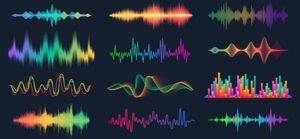Table of Contents
Effects in Sound
 Sound effects (SFX) are artificially created or enhanced sounds used in various multimedia applications to enhance the narrative, create atmosphere, and engage the audience. Here are some key aspects of sound effects in multimedia:
Sound effects (SFX) are artificially created or enhanced sounds used in various multimedia applications to enhance the narrative, create atmosphere, and engage the audience. Here are some key aspects of sound effects in multimedia:
Types of Sound Effects
Foley Effects:
- Definition: Foley is the reproduction of everyday sound effects that are added to films, videos, and other media in post-production to enhance audio quality.
- Examples: Footsteps, rustling clothes, and the sound of objects being handled.
- Purpose: To create a more realistic and immersive experience by synchronizing sounds with the visual action.
Ambient Sounds:
- Definition: Background sounds that create a sense of place or environment.
- Examples: Nature sounds (birds chirping, wind blowing), city sounds (traffic, chatter), and indoor sounds (clocks ticking, distant conversations).
- Purpose: To set the mood and context for a scene, making it feel more authentic.
Sound Design:
- Definition: The process of creating and manipulating sound to achieve a desired effect or atmosphere.
- Examples: Sci-fi sounds (spaceship engines, alien noises), horror sounds (creaking doors, eerie whispers).
- Purpose: To enhance storytelling and evoke specific emotions or reactions from the audience.
Musical Effects:
- Definition: Incorporation of music as a sound effect to enhance the emotional impact of a scene.
- Examples: Crescendo during a dramatic moment, soft music during a romantic scene.
- Purpose: To heighten emotional engagement and guide the audience’s feelings.
Transition Effects:
- Definition: Sounds used to signify a change or transition in a scene or narrative.
- Examples: Whooshing sounds during scene changes, swells of music during a montage.
- Purpose: To smooth transitions and maintain the flow of the narrative.
Techniques for Creating Sound Effects
- Recording: Capturing real-world sounds using microphones and recording equipment. This can include field recordings or studio sessions.
- Synthesis: Using electronic instruments or software to create sounds from scratch. This is common in music production and sound design for films and games.
- Manipulation: Altering recorded sounds using audio editing software. Techniques include pitch shifting, time stretching, reverb, and adding effects like distortion or echo.
- Layering: Combining multiple sound elements to create a richer and more complex sound. For example, layering different animal sounds to create a more convincing wildlife scene.
Importance of Sound Effects
- Enhancing Realism: Sound effects add authenticity to multimedia content, making it feel more believable and immersive.
- Emotional Engagement: Well-placed sound effects can evoke emotions and enhance the audience’s connection to the story.
- Guiding Attention: Sound effects can direct the audience’s focus to specific actions or elements within a scene, helping to convey important information.
- Creating Atmosphere: Ambient sounds and sound design contribute to the overall mood and tone of a piece, influencing how the audience perceives the narrative.
- Supporting Storytelling: Sound effects can reinforce the narrative by providing context, enhancing character actions, and signaling changes in the story.
You May Like to Browers More




